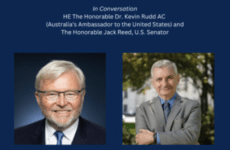By: Elizabeth Wellington
Posted In: News
Abercrombie & Fitch fashions are a lot like Gap’s this fall: lots of denim, polos and soft cardigans.
But to the college-age shopper, Abercrombie is “so over”; Gap is what’s up.
“Abercrombie lost it when they became a little `too white’ with their advertising. They lost and alienated a lot of people who didn’t see themselves or their friends represented,” explains David Morrison, founder and chief executive officer of TwentySomething Inc., a Radnor-based firm that analyzes the shopping habits of the 18-to-35 set.
Morrison helps the nation’s top fashion, electronics and food brands market themselves so they stay on the minds of consumers in their teens and 20s.
It’s six weeks into the fall 2004 semester, and young people are rewriting the “hot” brands list because of more reserved fashion trends and a still-weak economy. Dunkin’ Donuts is creeping up on Starbucks. Mitsubishi is edging out Honda.
Fashion-wise, college kids are leaving behind the late-`90s low-riders and sliding into tweeds with ribbon-trimmed preppy style. Tommy Hilfiger, Polo and J. Crew are “riding high,” Morrison says. LaCoste, with its brightly colored mini-polo shirts and tennis dresses, is hip, too.
The vintage craze has made Converse All Stars the tennis shoes of choice. Adidas are a cool second. Pumas, Morrison adds, are on the cusp of hotness, thanks to their old-school-rap connection. Nikes, namely Air Force Ones, and Reeboks are falling off.
“This market won’t wear those as much, unless they’re (ball) players,” Morrison says.
College students would rather be caught dead than wearing shoes from Payless, but they want shoes from DSW Shoe Warehouse.
They love Target and Wal-Mart, but can do without Kmart.
Philosophy’s cinnamon bun, blueberry pie, and orange sherbet-scented shampoos, conditioners and bath gels are the preferred shower-caddy fillers, pushing aside long-popular Bath & Body Works. (We can thank the nesting trend for that.) Also, Morrison says, Burt’s Bees all-natural makeup is a must-have.
Revlon and Avon are beating out MAC and Bobbi Brown, because they are more affordable, yet college girls would rather spend big money on a dress they bought from a boutique. (Think Nicole Miller or Nanette Lepore.)
“They are super-expensive, and teens aren’t convinced that these (makeup) brands are any better than what they can get at the drugstore,” Morrison says, ” … but when they get dressed up, they are going really high end.”
Today’s young adults have gobs of disposable income, but they have attention deficits when it comes to brand loyalty. As with the Generation X-ers and baby boomers before them, cost and packaging are the No. 1 factors that drive spending habits.
These youngsters, however, are picky about how they receive sales pitches. They prefer to get them through their e-mail in-boxes, music videos, video games, or on Web sites. They have little time for casual conversation and magazines.
They are marketing-savvy and understand business, Morrison says, even if it’s on a superficial level.
“They not only know what focus groups are, chances are they’ve been a part of one.”
Morrison has followed college students’ spending habits since his days at Haverford. Back then, he had an out-of-a-dorm-room business selling electronics- VCRs, radar detectors and CD players- with customers on 14 campuses.
He grew up with entrepreneurship and marketing: His father is a retired vice president of marketing for Lipton; his mother is an independent college guidance counselor.
Morrison started TwentySomething Inc. when he was 22. At the time, he thought major businesses were full of 50-year-old executives trying to understand people in their 20s.
If you ask Morrison, TwentySomething Inc. was one of the first consulting companies to niche-research the youth market- before Soul Kool and Teenage Research Unlimited.
His first projects included refining programs at the Entrepreneurial Center at the Wharton School of Business and helping Vibe Magazine fit into urban and suburban worlds. His company developed a strategy for Nokia cell phones to market color face plates. (He’s tight-lipped about other work he’s done because of nondisclosure contracts.)
Morrison has five employees and keeps satellite offices in Mexico City, Sydney, Australia, and Seoul, South Korea, to pick the brains of teens across the globe.
He spends his days talking to his target market in the malls and setting up focus groups across the world. Right now, he says, he’s working with more than 60 companies, more than half of which have made the Fortune 500.
Morrison’s book, “Marketing to the Campus Crowd: Everything You Need to Know to Capture the $200 Billion College Market” (Dearborn Trade Publishing, $25), has sold 3,500 copies. That’s a really good number, says Courtney Goethals, a spokeswoman for Dearborn Trade, because its market is so specific.
The book is required reading for the 20-plus directors at the National Association of College Stores, an organization that tracks the success of college bookstores.
“Those of us who’ve gone to college, we tend to base our paradigm of what college students want today … on what we wanted as students,” says Marianne Wascak, vice president of marketing at the association.
“But David does a good job at pointing out that students these days are different. They don’t trust corporations like we used to. Just because you give a college student something for free doesn’t mean they are going to buy it.”
On a recent afternoon, Morrison stands in front of the University of Pennsylvania’s Barnes & Noble campus bookstore. At 37, he has strawberry-blond hair that’s graying at the temples, but his face is line-free.
He talks at a rapid clip, totally excited about his recent trip to New Orleans, where he launched a campaign to hip up a fast-food chain. Ask him the specifics, and he gets cagey. An experienced businessman, he refuses to divulge key details.
In the store, current best-sellers are on the bottom floor, near the magazines, and in the back is every laptop accessory imaginable, from label makers to cameras.
On the top floor are the textbooks.
But the cafe is where the “it” brands are evident. The college palate is much more sophisticated these days, Morrison explains, so the cafe offers scones and flavored coffee.
Young consumers are making buying decisions based on how healthy they perceive a product to be, how well it fits into their lifestyle, and how diverse the advertisements are, he says. Right now, this age group is on a health kick.
That’s why the front of the store is full of Fiji water (kids can’t resist the squared-off, blue bottle) and VitaWater. For snacks, it’s all about Odwalla energy bars and big plastic tubs of trail mix.
Students are getting what they want, Morrison surmises.
“This is a market that marketers cannot afford to ignore. … If they lose this pulse for a second, they’re going to wake up and wonder why their brand is no longer relevant.”
Knight Ridder Newspapers
(KRT)
c 2004, The Philadelphia Inquirer.
Visit Philadelphia Online, the Inquirer’s World Wide Web site, at http://www.philly.com/
Distributed by Knight Ridder/Tribune Information Services.














